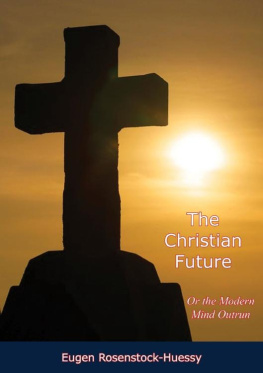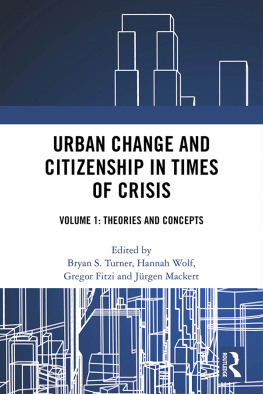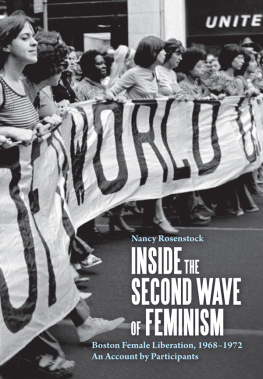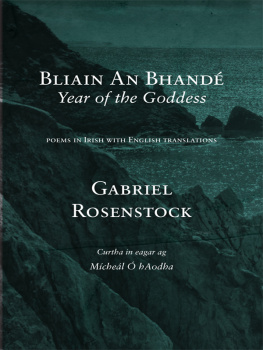In the Cross of Reality
Volume 1
In the Cross of Reality
Volume 1
The Hegemony of Spaces
Eugen Rosenstock-Huessy
Wayne Cristaudo
Frances Huessy
editors
Jrgen Lawrenz
First published 2017 by Transaction Publishers
Published 2017 by Routledge
2 Park Square, Milton Park, Abingdon, Oxon OX14 4RN
711 Third Avenue, New York, NY 10017, USA
Routledge is an imprint of the Taylor & Francis Group, an informa business
Copyright 2017 by Taylor & Francis
All rights reserved. No part of this book may be reprinted or reproduced or utilised in any form or by any electronic, mechanical, or other means, now known or hereafter invented, including photocopying and recording, or in any information storage or retrieval system, without permission in writing from the publishers.
Notice:
Product or corporate names may be trademarks or registered trademarks, and are used only for identification and explanation without intent to infringe.
ISBN: 978-1-4128-6507-4 (hbk)
Library of Congress Cataloging-in-Publication Data
A catalog record for this book has been requested
To the memories of
Freya von Moltke (19112010)
Margrit Huessy (18931959)
One may as readily depart from the straight and narrow by lingering too long on the straight and narrow.
Theodor Mommsen, Rmische Forschungen [Roman Studies] II, 25
In fine, you will scarcely find any land which is still in the hands of its original inhabitants: all peoples have become confused and intermingled: one has come after another: one has wished for what another scorned: some have been driven out of the land which they took from another. Thus fate has decreed that nothing should ever enjoy an uninterrupted course of good fortune.
Seneca, Ad Helviam Matrem De Consolatione [The Consolation to Helvia] VII (10) (Aubrey Stewart, trans.)
Contents
The philosopher and scholar Jrgen Lawrenz, a native German speaker, who emigrated to Australia as a teenager, undertook the initial draft of this translation. We then went through the translation, sentence by sentence, and brought the text closer to Rosenstock-Huessys stylistic idiosyncrasies, theoretical lexicon, and consistency with the overall intentions of this work and his corpus as a whole.
We are grateful to the Literary Heirs of Eugen Rosenstock-Huessy for their support of this projectin particular to Mark Huessy, who has been closely associated with the project from the start, and has come to our rescue on many occasions when we were lost in translation. Ray Huessy was also invaluable in his assistance. It was Ray who nailed the translation of the title, after what seemed like an endless discussion of how to capture the precise shades of bermacht. We also acknowledge the encouragement of the Rosenstock-Huessy Society of North America (Norman Fiering, Secretary), and Gottfried Paasche, who supported the concept of a translation from the beginning. Of the many who have also played a role in keeping Rosenstock-Huessys name and work alive, we acknowledge the lifelong contributions of Clinton Gardner, Lise van der Molen, and Harold Stahmer.
Had Matthew Del Nevo not introduced me to Jrgen Lawrenz, the work would still be untranslatednearly 80 years after the publication in German, and two interim attempts. Michael-Gormann Thelen was a challenging and brilliant dialogue partner with me, and a strong source of information.
One person, above all, made this project possible. My dear friend and former Head of the School of Modern Languages and Cultures (SMLC) at the University of Hong Kong, Heung-wah Wong. He believed enough in my passion to help bring Rosenstock-Huessy to a larger audience that he provided funds from our school to have this volume translated. I cannot thank him enough. My gratitude also extends to the publishing committee of the SMLC at the University of Hong Kong, not only for endorsing the project, but for continuing to ensure funding after Heung-wah Wongs term of Headship was passed onto Kendall Johnson. Kendall was also extremely supportive, and helped ensure that this translation could be completed. I am also thankful to Charles Darwin University, my present employer, for enabling me to continue this project. I would also like to express my deep appreciation to the late Professor Irving Louis Horowitz for his openness and support, and critical eye, which forced us to improve this manuscript. Finally, we thank all of those who have persisted in preserving and publishing Rosenstock-Huessys work. We hope that this translation justifies that labor.
Wayne Cristaudo
This translated edition differs somewhat from the way chapters and subsections appear in the original text. Readers comparing it to any of the German editions will notice that this translation contains numbered chapters within each of the four parts, instead of Rosenstock-Huessys mixture of lettered and numbered subsections. Sections and subsections retain their original structure, but are assigned, in some cases, different heading levels. We have retained the original architecture of the four essential parts to the book and the sequence of the chapters. In adhering to the publishers editorial style of numbering chapters, we believe we have made this volumes overall structure easier to follow.
This work contains editorial notes and translations of Rosenstock-Huessys footnotes from his original text. The editorial Notes (signaled in Arabic numerals) and translated Author References (in Roman numerals) appear at the end of each chapter.
All editorial insertions in the text appear in square brackets [ ]. Each of these falls into one of three categories:
The passage is from Rosenstock-Huessys post-publication notes in his own copy (referred to as his correction copy), the essential text for this translation.
The original German is sufficiently difficult or ambiguous that the translation has required an interpretive or descriptive word or two.
The German terms have ambiguous or double meanings; we have chosen one of those meanings and have placed the German word Rosenstock-Huessy used in brackets, for reference.
In some instances, references to other sections of the text appear in parentheses in running text. These are Rosenstock-Huessys notes in the original text. We have made every effort to respect the original German text notes, while adhering to American editorial style. Respect for the original text guided our decision making, even though it has created occasional stylistic inconsistencies.
To meet page length requirements and to enhance overall readability, we have abridged the translation, cutting approximately 11 percent of the original text. We believe the resulting text is not diminished in clarity, meaning, or philosophical substance. The criteria for excision were:
Repetition of ideas expressed elsewhere in the text.
Discursions that distract from the primary point in the development of an argument, and which do not contain any additional historical, philosophical, or sociological insights.
Polemical asides and interpretations of now-obscure or otherwise obsolescent social practices.











